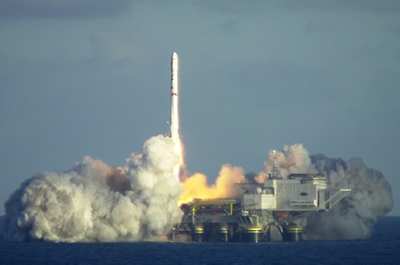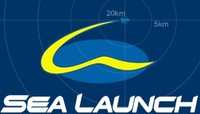Says First Stage Anomaly Resulted In January Accident
Sea Launch reports significant progress in the investigation
into the cause of an unsuccessful January 30 launch attempt, and
repairs to the Odyssey Launch Platform.

Sea Launch uses a mobile sea platform for equatorial launches of
commercial payloads on specialized Zenit 3SL rockets. As of January
2007 it had assembled and launched 24 rockets, with two
failures and one partial failure.
As ANN reported, Sea Launch
lost both its rocket and the commercial communications satellite
destined to serve Netherlands-based SES New Skies in an
unsuccessful launch attempt this past January, as the Zenit-3SL
rocket exploded on the mobile floating launch platform stationed in
the equatorial Pacific.
The Sea Launch consortium of four companies from the United
States, Russia, Ukraine and Norway was established in 1995, and its
first rocket was launched in March 1999. The national space
agencies of Russia and Ukraine formed an interagency commission in
early February to investigate the cause of the incident and
determine the necessary corrective actions. The commission recently
concluded its investigation and issued a summary statement to Sea
Launch, indicating an anomaly within the first stage engine caused
early termination of thrust, resulting in the loss of the
mission.
The Sea Launch Failure Review Oversight Board (FROB) is meeting
this week in Dnepropetrovsk, Ukraine, with representatives of the
interagency commission and Sea Launch partner companies, to
evaluate the commission's findings regarding the root cause of the
anomaly and recommended corrective actions. The FROB is comprised
of Sea Launch technical leadership and US aerospace industry
experts as well as customer representatives. Upon completion of the
meetings, the FROB Chairman will determine whether to close the
FROB and begin implementation of the recommended corrective actions
or to keep the FROB open for further investigation and
evaluation.
 Concurrently, the Sea Launch team
has completed its damage assessment phase of the Odyssey Launch
Platform, including repair and recertification requirements and
scheduling of repair activities. The team is now engaged in a fully
integrated recovery process to restore all damaged systems back to
their original operating capability. The most significant of these
efforts will be the construction and installation of a new gas
deflector located beneath the launch pad, replacement of
heat-affected cable and wiring, replacement of the launch support
umbilical interface to the launch vehicle, and painting of the
external surfaces.
Concurrently, the Sea Launch team
has completed its damage assessment phase of the Odyssey Launch
Platform, including repair and recertification requirements and
scheduling of repair activities. The team is now engaged in a fully
integrated recovery process to restore all damaged systems back to
their original operating capability. The most significant of these
efforts will be the construction and installation of a new gas
deflector located beneath the launch pad, replacement of
heat-affected cable and wiring, replacement of the launch support
umbilical interface to the launch vehicle, and painting of the
external surfaces.
The one-of-a-kind gas deflector -- a 250-metric ton steel
structure that directs the engine exhaust away from the platform
and controls the acoustic environment -- is being built in St.
Petersburg, Russia, by the original subcontractor. The Design
Bureau of Transport Machinery (DBTM), Sea Launch's Russian
contractor for much of the launch support equipment, is managing
this effort. Upon completion of the fabrication of the deflector,
DBTM will ship the structure to Sea Launch Home Port for
installation on the Launch Platform. Additional heavy industrial
repair work and painting will be performed at a shipyard on the
West Coast of North America.
Based on current progress, Sea Launch anticipates the FROB
activity will be completed by June, followed by implementation of
the necessary corrective actions leading to return to flight. The
Launch Platform repair and recertification operations are expected
to be completed in September.
The Sea Launch partners -- Boeing, RSC Energia, SDO Yuzhnoye/PO
Yuzhmash and Aker ASA -- remain fully committed to working together
to resolve this anomaly and recover from its consequences for a
Return to Flight in October.
 TikToker Arrested After Landing His C182 in Antarctica
TikToker Arrested After Landing His C182 in Antarctica Classic Aero-TV: Versatile AND Practical - The All-Seeing Aeroprakt A-22 LSA
Classic Aero-TV: Versatile AND Practical - The All-Seeing Aeroprakt A-22 LSA ANN's Daily Aero-Term (06.27.25): Hazardous Weather Information
ANN's Daily Aero-Term (06.27.25): Hazardous Weather Information ANN's Daily Aero-Linx (06.27.25)
ANN's Daily Aero-Linx (06.27.25) Aero-News: Quote of the Day (06.27.25)
Aero-News: Quote of the Day (06.27.25)




